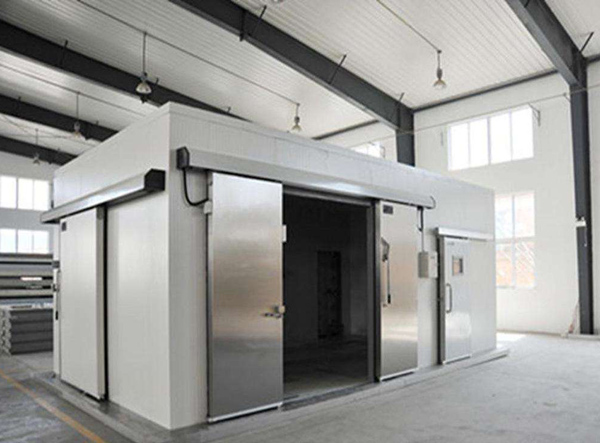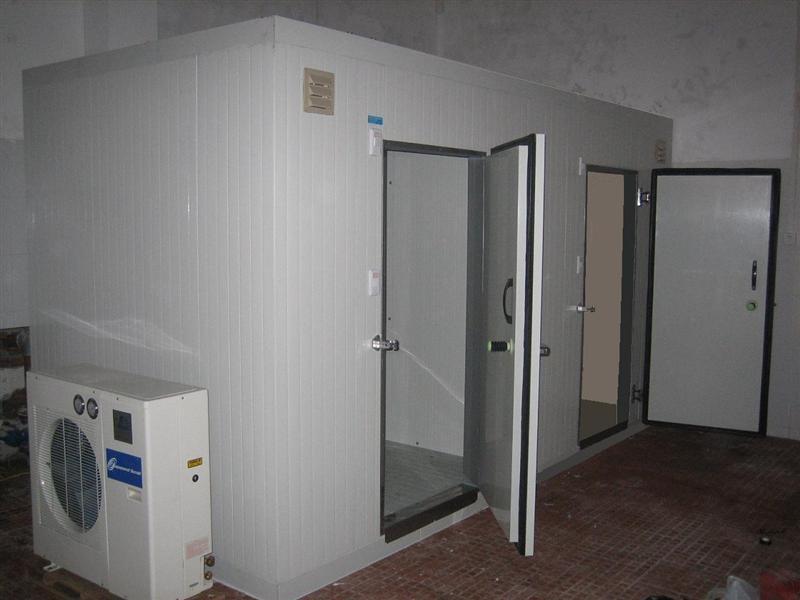Compressor: It acts to compress and drive the refrigerant in the refrigerant circuit. The compressor extracts the refrigerant from the low-pressure zone, compresses it, and sends it to the high-pressure zone for cooling and condensing. The heat is dissipated into the air through the heat sink. The refrigerant also changes from a gaseous state to a liquid state, and the pressure increases.
Condenser: It is one of the main heat exchange equipment in the cold storage refrigeration system. Its function is to cool and condense the high-temperature refrigerant superheated vapor discharged from the assembled cold storage compressor into a high-pressure liquid.
Evaporator: It absorbs the heat in the cold storage, so that the liquid refrigerant absorbs the heat transferred from the freezer and evaporates under the low pressure and low temperature evaporation, and becomes a gaseous refrigerant. The gaseous refrigerant is sucked into the compressor and compressed. Drain into the condenser to remove heat. Basically, the principle of the evaporator and the condenser is the same, the difference is that the former is to absorb heat into the library, and the latter is to discharge heat to the outside.
Liquid storage tank: storage tank for freon to ensure that the refrigerant is always in a saturated state. To
Solenoid valve: First, it prevents high-pressure part of the refrigerant liquid from entering the evaporator when the compressor is stopped, to prevent the low pressure from being too high when the compressor is started next time, and to prevent the compressor from liquid shock. Second, when the temperature of the cold storage reaches the set value, the thermostat will act, and the solenoid valve will lose power, and the compressor will stop when the low pressure reaches the stop set value. When the temperature in the cold storage rises to the set value, the thermostat will act and the solenoid valve will be When the low-pressure pressure rises to the compressor start-up setting value, the compressor will start.
High and low pressure protector: protect the compressor from high pressure and low pressure.
Thermostat: It is equivalent to the brain of the cold storage that controls the opening and stopping of the cold storage refrigeration, defrosting, and the opening and stopping of the fan.
Dry filter: filter impurities and moisture in the system.
Oil pressure protector: to ensure that the compressor has enough lubricating oil.
Expansion valve: also called throttle valve, it can make the high and low pressure of the system form a huge pressure difference, make the high pressure refrigerating liquid at the outlet of the expansion valve quickly swell and evaporate, absorb the heat in the air through the pipe wall, and exchange cold and heat.
Oil separator: Its function is to separate the lubricating oil in the high-pressure steam discharged from the refrigeration compressor to ensure the safe and efficient operation of the device. According to the oil separation principle of reducing the airflow speed and changing the airflow direction, the oil particles in the high-pressure steam are separated under the action of gravity. Generally, if the air velocity is below 1m/s, the oil particles with a diameter of 0.2mm or more contained in the steam can be separated. There are four types of oil separators commonly used: washing type, centrifugal type, packing type and filter type.
Evaporator pressure regulating valve: It prevents the evaporator pressure (and evaporating temperature) from falling below the specified value. Sometimes it is also used to adjust the force of the evaporator to adapt to changes in load.
Fan speed regulator: This series of fan speed regulators are mainly used to adjust the speed of the fan motor of the outdoor air-cooled condenser of refrigeration equipment, or to adjust the speed of the cooler of the cold storage.
Handling of common faults in cold storage refrigeration system
1. Refrigerant leakage: After the refrigerant leaks in the system, the cooling capacity is insufficient, the suction and exhaust pressures are low, and the intermittent “squeaking” airflow sound much louder than usual can be heard at the expansion valve. The evaporator has no frost or a small amount of frost on the corners. If the expansion valve hole is enlarged, the suction pressure will not change much. After the shutdown, the equilibrium pressure in the system is generally lower than the saturation pressure corresponding to the same ambient temperature.
Remedy: After the refrigerant leaks, do not rush to fill the system with refrigerant, but immediately find the leakage point, and fill it with refrigerant after repair. The refrigeration system adopting open-type compressor has many joints and many sealing surfaces, correspondingly more potential leakage points. During maintenance, attention must be paid to exploring the easy-to-leak links, and based on experience, find out whether there are oil leaks, pipe breaks, loose streets, etc. at a major leakage point.
2. Too much refrigerant is charged after maintenance: The amount of refrigerant charged in the refrigeration system after maintenance exceeds the capacity of the system, and the refrigerant will occupy a certain volume of the condenser, reduce the heat dissipation area, and reduce the cooling effect. The suction and exhaust pressures are generally higher than the normal pressure values, the evaporator is not solidly frosted, and the temperature in the warehouse is slowed down.
Remedy: According to the operating procedure, the excess refrigerant must be discharged at the high-pressure shut-off valve after a few minutes of shutdown, and the residual air in the system can also be discharged at this time.
3. There is air in the refrigeration system: the air in the refrigeration system will reduce the refrigeration efficiency, and the suction and discharge pressure will increase (but the discharge pressure has not exceeded the rated value), and the compressor outlet will be at the condenser inlet The temperature has increased significantly. Due to the air in the system, the exhaust pressure and exhaust temperature both increase.
Remedy: You can release air from the high-pressure shut-off valve several times in a few minutes after the shutdown, and you can also properly charge some refrigerant according to the actual situation.
4. Low compressor efficiency: The low efficiency of the refrigeration compressor means that under the same working conditions, the actual displacement decreases and the refrigeration capacity decreases accordingly. This phenomenon mostly occurs on compressors that have been used for a long time. The wear is large, the matching gap of each part is large, and the sealing performance of the valve is reduced, which causes the actual displacement to decrease.
Method of exclusion:
1. Check whether the cylinder head paper gasket is broken down and cause leakage, and if there is any leakage, replace it;
2. Check whether the high and low pressure exhaust valves are not tightly closed, and replace them if there are ones;
3. Check the matching clearance between the piston and the cylinder. If the clearance is too large, replace it.
5. Thick frost on the surface of the evaporator: The frost layer on the evaporator pipeline becomes thicker and thicker. When the entire pipeline is wrapped into a transparent ice layer, it will seriously affect the heat transfer and cause the temperature in the warehouse to fall below the required range. Inside.
Remedy: Stop defrosting, open the warehouse door to allow air to circulate, or use a fan to accelerate the circulation to reduce the defrosting time. Do not hit the frost layer with iron, wooden sticks, etc. to prevent damage to the evaporator pipeline.
6. There is refrigerating oil in the evaporator pipeline: During the refrigeration cycle, some refrigerating oil remains in the evaporator pipeline. After a long period of use, when there is more residual oil in the evaporator, its heat transfer effect will be seriously affected , There is a phenomenon of poor cooling.
Remedy: Remove the refrigerant oil in the evaporator. Remove the evaporator, blow it out, and then dry it. If it is not easy to disassemble, it can be blown out from the inlet of the evaporator with a compressor.
7. The refrigeration system is not unblocked: As the refrigeration system is not cleaned, after a certain period of use, dirt will gradually accumulate in the filter, and some meshes will be blocked, resulting in a decrease in refrigerant flow, which affects the refrigeration effect. In the system, the expansion valve and the filter at the suction port of the compressor are also slightly blocked.
Remedy: The micro-blocking parts can be removed, cleaned, dried, and then installed.
8. Refrigerant leakage: The compressor starts easily (when the compressor components are not damaged), the suction pressure is vacuum, the exhaust pressure is very low, the exhaust pipe is cool, and the sound of liquid water is not heard in the evaporator.
Elimination method: check the whole machine, mainly check the leak-prone parts. After the leakage is found, it can be repaired according to the specific situation, and finally vacuumed and filled with refrigerant.
9. Frozen blockage of expansion valve hole:
(1) Improper drying treatment of main components in the refrigeration system;
(2) The entire system is not fully vacuumed;
(3) The moisture content of the refrigerant exceeds the standard.
Discharge method: string a filter with moisture absorbent (silica gel, anhydrous calcium chloride) into the refrigeration system to filter out the water in the system, and then remove the filter.
10. Dirty blockage at the filter screen of the expansion valve: When there are more coarse powdery dirt in the system, the entire filter screen will be blocked, and the refrigerant cannot pass through, resulting in no refrigeration.
Discharge method: remove the filter, clean, dry, and reinstall it into the system.
11. Filter clogging: The desiccant is used for a long time and becomes a paste to seal the filter or dirt gradually accumulates in the filter to cause clogging.
Discharge method: remove the filter for cleaning, dry, replace the washed desiccant, and put it into the system.
12. Refrigerant leakage in the temperature sensing package of the expansion valve: After the temperature sensing agent in the temperature sensing package of the expansion valve leaks, the two forces below the diaphragm push the diaphragm upwards, the valve hole is closed, and the refrigerant cannot pass through the system, causing failure. During refrigeration, the expansion valve is not frosted, the low pressure is in a vacuum, and there is no sound of airflow in the evaporator.
Discharge method: shut down the shut-off valve, remove the expansion valve to check whether the filter is blocked, if not, use the mouth to blow the inlet of the expansion valve to see if it is ventilated. It can also be inspected visually or disassembled for inspection, and replaced when damaged.
13. There is residual air in the system: there is air circulation in the system, the exhaust pressure will be too high, the exhaust temperature will be too high, the exhaust pipe will be hot, the cooling effect will be poor, the compressor will run shortly, the exhaust pressure will exceed the normal value, forcing the pressure The relay is activated.
Exhaust method: Stop the machine and release air at the exhaust valve hole.
14. Shutdown caused by low suction pressure: When the suction pressure in the system is lower than the setting value of the pressure relay, it will be electrocuted and cut off the power supply.
Discharge method: 1. Leakage of refrigerant. 2. The system is blocked.
Post time: Nov-29-2021




